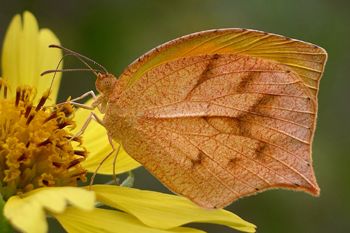 Common Mestra adult & caterpillar |
As I am preparing to teach an Audubon Society class on our local butterflies for the fifth year in a row, for the first time I am updating some of the information I will present. The basics, of course, don't really change. Butterflies still lay eggs and nectar at flowers, plus their caterpillars eat plants. However, this class also covers the species likely to be encountered here in Austin and how to identify them. When I led the first class, I had been studying central Texas insects pretty intensely for about ten years, and butterflies are about the most conspicuous group, so I was unlikely to miss them if they were present. I saw patterns in when populations waxed and waned. I noticed which species were consistent and which were unpredictable. I had a pretty good grasp of what was common or rare. Or so I thought.
Then, suddenly, last year was weird. It is not too unusual for southern species to end up here in central Texas, especially late in the year after months of warm weather. But they normally don't appear in large numbers. A small white butterfly called the Common Mestra is, in central Texas, anything but common. It is a tropical species that strays northward from the Rio Grande Valley during the summer and is sometimes seen occasionally in Austin. The fall of 2016, though, was filled with Mestra sightings. It was possible to see dozens at a time as they sought nectar on flowers. They were breeding as well, with caterpillars easily found on the nettle vine, Noseburn, that is their host. This particular population anomaly was fairly easy to explain. We had a winter mild enough for this species to survive in the area, and rainfall/weather conditions were perfect for its host plant. The annoying nettle vine flourished; it bothered us on our early spring hikes but turned out to be just what the Mestras needed to feed lots of hungry caterpillars. A couple of generations over the summer, and the end result was loads of adults.
 Common Mestra adult & caterpillar |
The Mestra wasn't the only case last year of butterflies invading from the tropics. I had never even seen a Tailed Orange, another Rio Grande Valley resident, until the fall of 2015. I thought I was very lucky to find one here in Austin. However, by the following autumn, they were so common that we saw them all the time. The same thing happened with a couple of white-skipper species. Even a daytime flying moth, the White-tipped Black, found in coastal habitats, showed up in large numbers for a few weeks.
An overly simplistic view could be that global warming is here and southern species are replacing the northern ones. Knowing that almost NOTHING in nature is simple,
 Tailed Orange |
It will be interesting to see if we have an influx of tropical butterflies this coming autumn. This summer was exceptionally devoid of most species, both local and strays. The weather was hot, as usual, but we also had a reasonable amount of rain, so the vegetation is adequate to support both larvae and the nectaring adults. Along with the decline in caterpillars, we've seen a corresponding decline in adults. Yes, there are a few here and there, but numbers and diversity are so low that, on a good day, we might see only ten or so species.
The one butterfly species that has made national news is the Monarch. There is much interest and research going into understanding its population fluctuations and migratory needs and considerations. This is definitely positive in that attention is focused on habitat and other aspects that affect not only one species but the whole faunal community, even if studies do not concentrate explicitly on the big picture. The ecology of a particular region is so complex that we'll never fully grasp all the implications of any single factor. Our observations continue, as do our speculations on cause and effect for any specific phenomenon. The limited perspective from which we must study, measured in decades instead of centuries, is one of the biggest challenges we face. One can never have enough data.